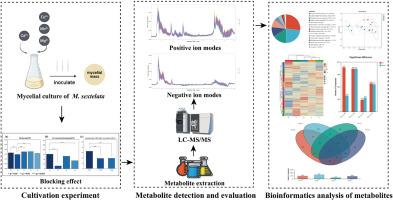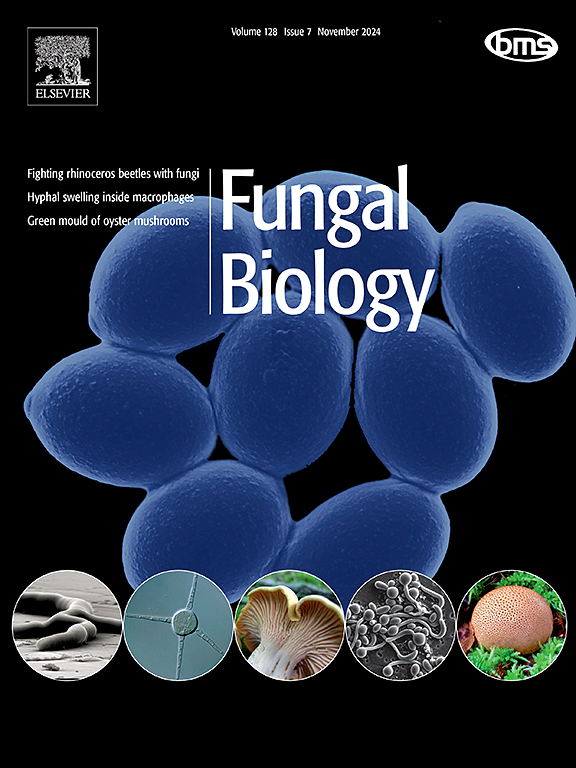UIon antagonism strategy for cadmium mitigation in Morchella sextelata: Physiological and metabolomic insights
IF 3
3区 生物学
Q2 MYCOLOGY
引用次数: 0
Abstract
Cadmium (Cd) contamination in edible fungi poses a significant threat to food safety. However, targeted strategies to regulate Cd uptake and enhance Cd stress tolerance in Morchella sextelata remain largely unexplored. Given that M. sextelata mycelia can autonomously adsorb beneficial metal ions to promote growth, regulating Cd absorption through ion–ion interactions emerges as a promising approach. In this study, under 1 mg/L Cd stress, the exogenous application of Fe2+ and Mn2+ at a 1:1 M ratio significantly increased mycelial biomass by 20.49 % and 22.11 %, respectively, and effectively reduced Cd accumulation. In contrast, Mg2+ led to a moderate biomass increase of 8.94 %. Notably, Fe2+ effectively inhibited Cd accumulation in mycelia, reducing Cd content by 81.76 %. Moreover, the addition of divalent ions significantly alleviated osmotic stress in the mycelia, preventing the efflux of sugars and proteins. LC-MS/MS-based metabolomic profiling identified 1446 metabolites. One-way ANOVA revealed distinct metabolic changes associated with metal ion treatments under Cd stress. KEGG pathway enrichment indicated that histidine metabolism plays a key role in the Cd stress mitigation process. VIP (Variable Importance in Projection) analysis further identified key metabolites involved in the repair response. Correlation analysis highlighted carnitine as a core metabolite significantly associated with phenotypic improvements across all treatments. In summary, this study presents the first attempt to regulate Cd accumulation in M. sextelata through divalent ion application. It provides novel insights into the physiological and metabolic mechanisms underlying this ion-mediated mitigation strategy

六口羊肚菌镉缓解的拮抗策略:生理和代谢组学见解
食用菌中的镉污染对食品安全构成重大威胁。然而,调节羊肚菌Cd吸收和增强其Cd胁迫耐受性的定向策略在很大程度上仍未被探索。鉴于M. sextelata菌丝体能够自主吸附有益金属离子促进生长,通过离子-离子相互作用调节Cd的吸收是一种很有前途的途径。在本研究中,在1 mg/L Cd胁迫下,外源施用1:1 M比例的Fe2+和Mn2+分别显著提高了菌丝生物量20.49%和22.11%,并有效降低了Cd积累。相比之下,Mg2+使生物量增加了8.94%。Fe2+能有效抑制菌丝中Cd的积累,使Cd含量降低81.76%。此外,二价离子的加入显著减轻了菌丝中的渗透胁迫,阻止了糖和蛋白质的外排。基于LC-MS/ ms的代谢组学分析鉴定出1446种代谢物。单因素方差分析揭示了镉胁迫下金属离子处理相关的明显代谢变化。KEGG途径富集表明组氨酸代谢在Cd胁迫缓解过程中起关键作用。VIP (Variable Importance in Projection)分析进一步确定了参与修复反应的关键代谢物。相关分析强调肉碱作为核心代谢物与所有治疗中表型改善显著相关。综上所述,本研究首次尝试通过二价离子的施用来调控六棱田中镉的积累。它为这种离子介导的缓解策略背后的生理和代谢机制提供了新的见解
本文章由计算机程序翻译,如有差异,请以英文原文为准。
求助全文
约1分钟内获得全文
求助全文
来源期刊

Fungal biology
MYCOLOGY-
CiteScore
5.80
自引率
4.00%
发文量
80
审稿时长
49 days
期刊介绍:
Fungal Biology publishes original contributions in all fields of basic and applied research involving fungi and fungus-like organisms (including oomycetes and slime moulds). Areas of investigation include biodeterioration, biotechnology, cell and developmental biology, ecology, evolution, genetics, geomycology, medical mycology, mutualistic interactions (including lichens and mycorrhizas), physiology, plant pathology, secondary metabolites, and taxonomy and systematics. Submissions on experimental methods are also welcomed. Priority is given to contributions likely to be of interest to a wide international audience.
 求助内容:
求助内容: 应助结果提醒方式:
应助结果提醒方式:


